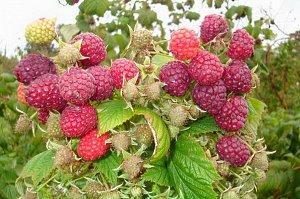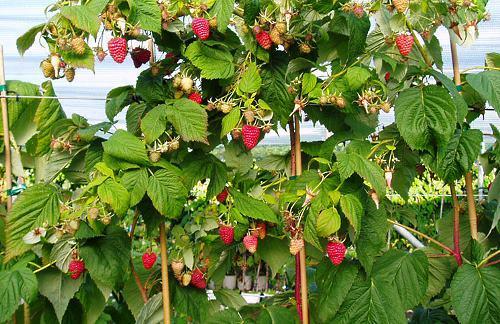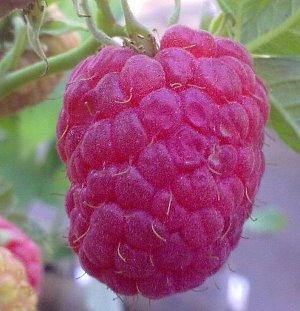Raspberry tree Tarusa - the most productive variety
 The fastest growing and most fruitful of berry crops is raspberry. Its fruits are very tasty and healthy, they love it fresh, they make preparations for the winter from raspberries, they can be dried. Therefore, raspberries are grown on every home or summer cottage, a raspberry tree receives a lot of positive reviews.
The fastest growing and most fruitful of berry crops is raspberry. Its fruits are very tasty and healthy, they love it fresh, they make preparations for the winter from raspberries, they can be dried. Therefore, raspberries are grown on every home or summer cottage, a raspberry tree receives a lot of positive reviews.
Currently, there are many varieties of this shrub, which allows you to get fresh products for a long time, picking up several varieties with different periods of fruiting.
Raspberry tree - what is it?
The raspberry tree includes the standard varieties of this berry, varieties that do not need support when growing. They hold well, the branches of the bush can bend under the weight of the berries, but they will not fall, since they are tough with shortened internodes. The raspberry tree is not a variety name, but a growing method.
With this method of growing a shrub, the branches that bear fruit are cut out and the tops of young shoots are pinched, which leads to the awakening of the lateral shoots. Leaving only one replacement shoot, you can get an erect, tree-like, non-leaning bush.

The number of side shoots of growth in standard raspberry varieties reaches 10 pcs. By autumn, they have a length of about 50 cm. After the leaves fall off, the bush looks like a small tree, which gave reason to call it that. With optimal care, such a bush will yield a yield much larger than a plant that has not been formed in this way. Increasingly, summer residents grow a raspberry tree on their site, reviews of which are usually positive.
Why choose the raspberry tree Tarusa
One of the most promising modern varieties for the personal economy is the Tarusa raspberry tree, it has:
- High productivity, with appropriate pruning can give two crops per season. The berries are very large (up to 14-16 g), beautiful elongated shape with a bright red color and shiny. They are easily removable.
- Berries with excellent taste and aroma, firm and withstand transportation well. The berries of the Tarusa raspberry tree can be consumed not only fresh, but also for all types of processing, because they have few seeds and they are very small.
- The root system resembles the root of a tree and does not give a lot of growth, that is, it does not "spread" over the site. When raspberries are grown for berries, and not for planting material, this quality is a big plus.
- It is possible to grow without supports or stakes, since the plant has tough, thick and strong shoots that do not have thorns.
- High winter hardiness and relatively good resistance to many diseases.
Other features of the variety
 This raspberry is a mid-late variety. Bushes, with proper care of the raspberry tree, are powerful, compressed, of medium height and pronounced erect, up to 1.5 - 2 meters high. The leaves are very beautiful and large, with a corrugated surface and a dark green color. The plant is very beautiful in general and can be used for decorative purposes as well.
This raspberry is a mid-late variety. Bushes, with proper care of the raspberry tree, are powerful, compressed, of medium height and pronounced erect, up to 1.5 - 2 meters high. The leaves are very beautiful and large, with a corrugated surface and a dark green color. The plant is very beautiful in general and can be used for decorative purposes as well.
Growing and caring for the Tarusa raspberry tree
Because remontant varieties of raspberries in the fall, active vegetative development continues, the planting of a raspberry tree is carried out only in spring. The plant planted in autumn does not have time to mature and dies from frost. In the year of planting, a large harvest should not be expected, the young bush will lag behind in development from those previously planted.
The raspberry tree grows thick and wide, so it should be planted at a distance of a meter from bush to bush, and at least 1.8 m is left between the rows.In order for the raspberry tree to develop well, planting is accompanied by top dressing, that is, humus or peat with manure... Repaired raspberry varieties need fertile soil.

During the growing season, plantings are mandatory watered abundantly, but it is also not necessary to fill in so that the roots do not rot.
If in winter it is possible to lower temperatures under -30 C, then after the end of fruiting, the stems of the bush should be bent to the soil, if this is not done in time, the shoots will become stiff, as a result of which they will become brittle.
Raspberry plantations must be weeded, loosened and mulched. Soil mulching is essential:
- in summer it protects the soil from overheating, its temperature remains uniform;
- mulch interferes with the rapid evaporation of moisture,
- slows down the growth of weeds and increases soil fertility;
- in winter, it serves as a shelter for the roots and protects them from freezing.
In addition, the raspberry tree must be fed, otherwise it will not be able to develop to its characteristic sizes, and one cannot do without fighting diseases and pests. Without carrying out all the necessary agrotechnical measures, it is impossible to get such a raspberry tree Tarusa, as in the photo below.
Pruning a raspberry tree
 The raspberry tree is formed by the double pruning method. The first pinching of the shoots is performed after planting in May, when the shoots reach 60 cm. The stems are shortened by 5-10 cm. After pinching, lateral branches grow in the leaf axils, which are subjected to a second pinching in the spring of next year. After the danger of frost has disappeared, the branches should be cut off by 15 cm. Later, many fruit-bearing branches will appear on the stem, from which a rich harvest can be harvested in early autumn.
The raspberry tree is formed by the double pruning method. The first pinching of the shoots is performed after planting in May, when the shoots reach 60 cm. The stems are shortened by 5-10 cm. After pinching, lateral branches grow in the leaf axils, which are subjected to a second pinching in the spring of next year. After the danger of frost has disappeared, the branches should be cut off by 15 cm. Later, many fruit-bearing branches will appear on the stem, from which a rich harvest can be harvested in early autumn.
Berries of remontant raspberry varieties are also formed on the growths of the current season. The method of pruning shoots depends on how many crops you want to harvest per season. When pinched twice, the plants will yield one crop. To obtain two harvests, pruning is done in the fall, in the spring only frozen or dried branches are cut.
Good day. Couldn't find this variety in the federal variety register. Can you tell me what I'm doing wrong?
how to order a raspberry tree
We do not sell seedlings. Contact the nearest nursery in your area.
I bought a raspberry tree through the Becker website
Do not take anything in Becker, out of 12 raspberry trees 1 took root, the strawberries came all sick with a fungus, infected the whole garden and died
I planted a raspberry tree in the fall, now it has borne fruit, but it dries up, how can I process it or like spati
How does your raspberry tree dry up? If the leaves are curled up, this could be a sign of parasites, particularly aphids. She lives mainly on the tops of the shoots, so they must be cut and burned. For prevention, the treatment of bushes before flowering with a weak solution of bitoxibacillin (1%) is practiced.
Raspberries can dry out from lack of moisture. Water your tree regularly, especially during the fruiting period. Since the roots of the raspberry tree are close to the surface of the earth, the bushes must be mulched for additional protection from drying out, which is destructive for them.
Drying of leaves, stunted growth and shedding of berries in raspberries can be the result of a lack of nitrogen in the soil.How long has the bush been fed with nitrogen fertilizers? You can try pouring a complex solution of 60 g of superphosphate, 40 g of ash and 30 g of ammonium nitrate on a bucket of water on raspberries.
The raspberry bush was planted this year, the seedling was with a closed root system, this year it has already given
berries, feeding, developing well. Question: there is a young growth around the root collar in diameter. What to do with her now? If not removed and allowed to grow, then do you need to pinch?
Hello. Today I dug my tree, acquired in 2016, to propagate from the roots, and saw a very similar picture. There were practically no roots. What should I do now? Is it possible to cut off this keel and try to root the rest? If possible, do you need processing? Than? And isn't it too late for rooting? I really hope for a quick answer, tk. the dug tree lies at home.
This is most likely a root cancer. Some gardeners recommend cutting off the growths and treating them with copper sulfate, but in most cases this has no effect and it is no longer possible to save the plant. Your tree has a large lesion, and if you completely remove the root system, it will not recover. Unfortunately, it will have to be burned.
Thank you very much!
This year I bought 10 bushes of a raspberry tree in BECKER. Of these, only 2 started. And the rest stick out dry sticks. I planted everything as it should be, fed. But still no movement. What to do? Or what has been done wrong.
Becker only resellers, I also flew with this company strawberries came without sprouts
If the leaves did not appear on the seedlings by the summer, then they did not take root. Perhaps the bushes were caught with damage to the root system.
In the spring, the raspberry variety Tarusa was planted, it bore fruit, in September a replacement sprout came out and, unfortunately, was mowed with weeds. Could a new sprout appear next spring?